We think that it was only men who created the world’s most famous artworks.
Look at The Starry Night, Salvator Mundi, or the Mona Lisa painting, for that matter!
One thing that is common between them is that their creators were men.
Does that mean women from traditional times were incapable of accomplishing great heights?
No. Not at all.
The matter of fact is that news channels and mainstream media never exclusively covered these female painters’ stories that influenced the masses.
Our world was largely dominated by men, who would silence women. Especially when they were entering the art realm.
Damn, this patriarchal society—the root cause of many gender injustices—never enabled women to express themselves through art and work shoulder to shoulder with other men.
But thanks to those who stood up for women’s rights and built a platform to express their ideas.
Female painters, who were silenced by their surroundings, later became the voice of the art world, in no time.
Here I’ve listed 17 female painters who fought against the odds, and were anonymous contributors to the art world.
Table of contents
- Frida Kahlo
- Georgia O’Keeffe
- Mary Cassatt
- Tamara De Lempicka
- Elisabeth Louise Vigée Le Brun
- Sofonisba Anguissola
- Artemisia Gentileschi
- Judith Leyster
- Rosa Bonheur
- Berthe Morisot
- Hilma af Klint
- Yayoi Kusama
- Angelica Kauffman
- Helen Frankenthaler
- Catharina Van Hemessen
- Louise Bourgeois
- Adélaïde Labille-Guiard
- Why Have There Been No Great Female Artists?
- End Note:
1. Frida Kahlo
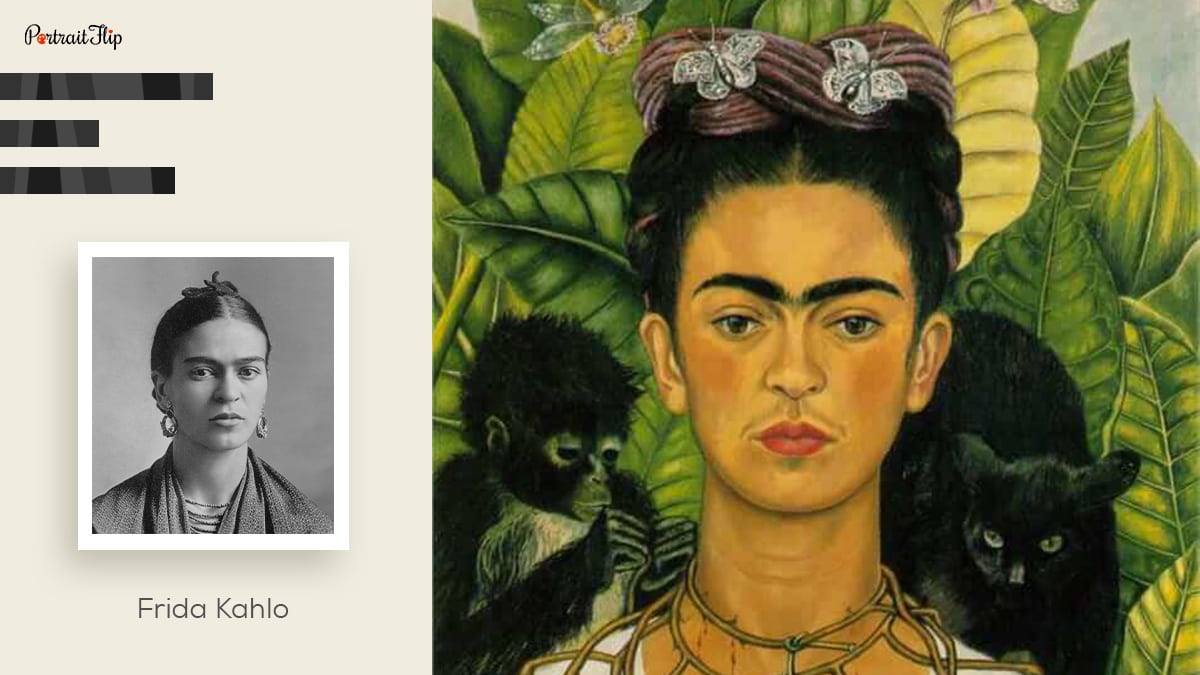
| Date of Birth | 6 July 1907 |
| Date of Death | 13 July 1954 |
| Nationality | Mexican |
| Known For | Self Portraits, Paintings |
| Periods Belong To | Surrealism, Cubism, Symbolism, Modern Art, Realism |
| Famous Paintings | The Two Fridas, The Wounded Deer, Self-Portrait with Thorn Necklace and Hummingbird, and more |
Frida’s success is astonishing. The fame and admiration that came this female painter’s way were immeasurable.
She seemed like a lady with a solemn look. But she was a warrior who endured several chronic pains.
She is arguably the most successful Mexican artist who would produce art from lying in bed with excruciating pain to holding a higher position in various groups catering to women’s empowerment.
The famous female painter’s ideology was quite rebellious, and the pain she had endured till the last breath was unexplainable.
Frida Kahlo’s artworks explain a lot of her agony and melancholy life because she had a tumultuous marriage with a surrealist painter, Diego Rivera.
Frida Kahlo was a great talent who always chose her passion and pursued it despite all the odds.
The iconic paintings of Frida covered different aspects of her life and represented the culture of Mexico, which she had been a part of.
2. Georgia O’Keeffe
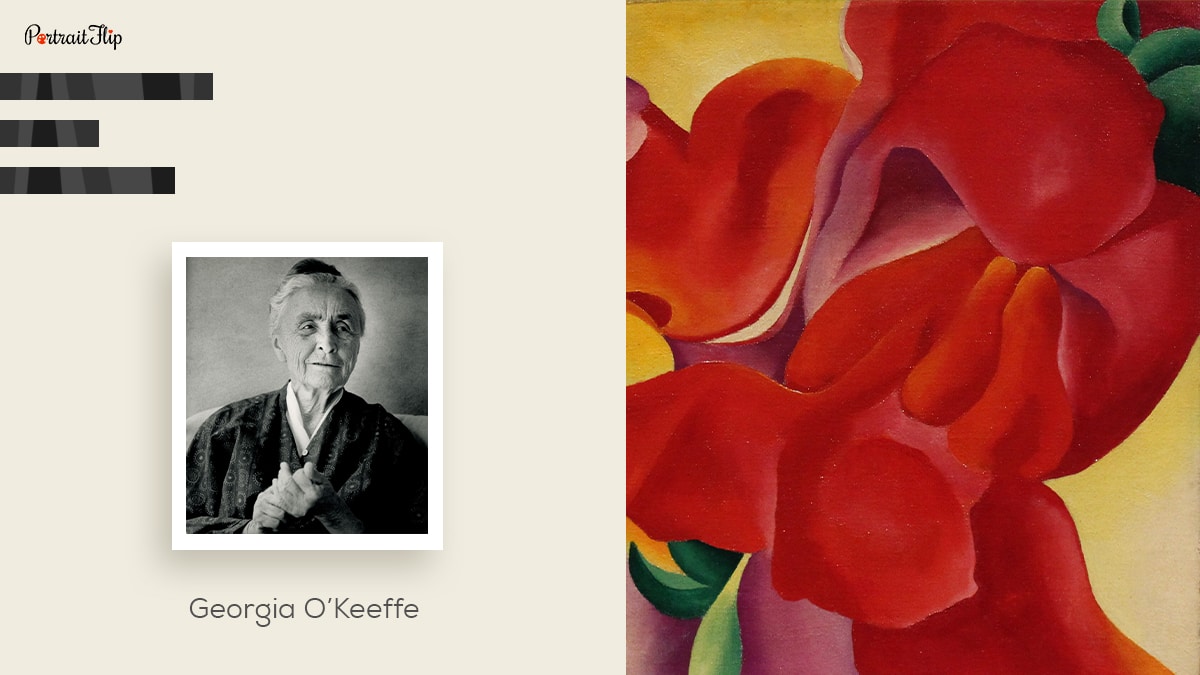
| Date of Birth | 15 November 1887 |
| Date of Death | 6 March 1986 |
| Nationality | American |
| Known For | Painting Flowers and Landscapes |
| Periods Belong To | Modernism, Precisionism, American Modernism |
| Famous Paintings | Jimson Weed, White Flower No. 1, Oriental Poppies, Blue and Green Music, Sky Above Clouds Iv and more |
Georgia O’Keeffe will always be remembered as the most successful American female artist.
She was a self-made painter who shaped her style by experimenting with subjects.
Her works were abstract, which were well-received by many art critics.
And the ones that caught people’s attention had animal skulls and mountainous landscapes.
O’Keeffe was one such famous female painter who defended her work for years. They were seen as sensuous due to their colors and representation of subjects.
She knew that her works would trigger many people as she believed that she couldn’t please everyone who was fond of art.
The world of art saw her as a successful woman painter, but did you know most of Keeffe’s artworks were intertwined with her husband’s.
And her works raised many eyebrows because the depiction of sexuality in art was a taboo.
But she stuck with her belief systems, and painted as many flower paintings as she could, which, if looked closely, would show female genitals.
Georgia’s works may have had a controversial element, but it enabled a large female audience to work on ideas that she believed in.
3. Mary Cassatt
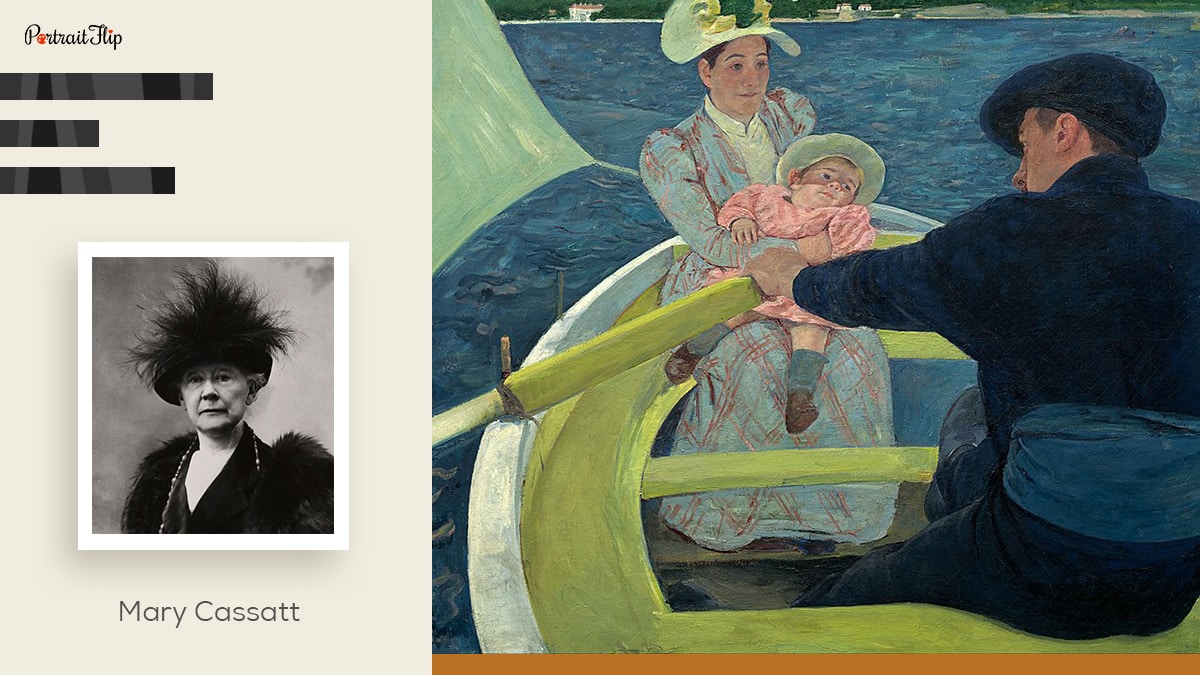
| Date of Birth | 22 May 1844 |
| Date of Death | 14 June 1926 |
| Nationality | American |
| Known For | Paintings that depict women and children |
| Periods Belong To | Impressionism, American Modernism, Modern Art |
| Famous Paintings | Little Girl in a Blue Armchair, In the Loge, Woman with a Pearl Necklace in a Loge, and more |
Mary Cassatt’s works speak on behalf of her capabilities and talent.
The America’s most iconic female painter was among the three seminal figures of Impressionism.
Half of her time was spent in France, where she became a part of Impressionism, and later she stunned the world with her several magnificent impressionist artworks.
The European art wasn’t popular in America, but her keen interest in and contribution to it caught the attention of various art collections of the United States.
The lady artist was a self taught artist who became mature and prolific after befriending Edgas Degas—the prominent figure in Mary Cassatt’s life. He helped her shape her painting techniques.
Cassatt produced some historical pieces, and her works even inspired a massive audience of aspiring female painters.
Her works are still studied, including A Woman and a Girl Driving, In the Loge, and the famous Little Girl in a Blue Armchair.
Some of her works are hung, along with other renowned artist’ paintings at the famous Louvre Museum.
4. Tamara De Lempicka
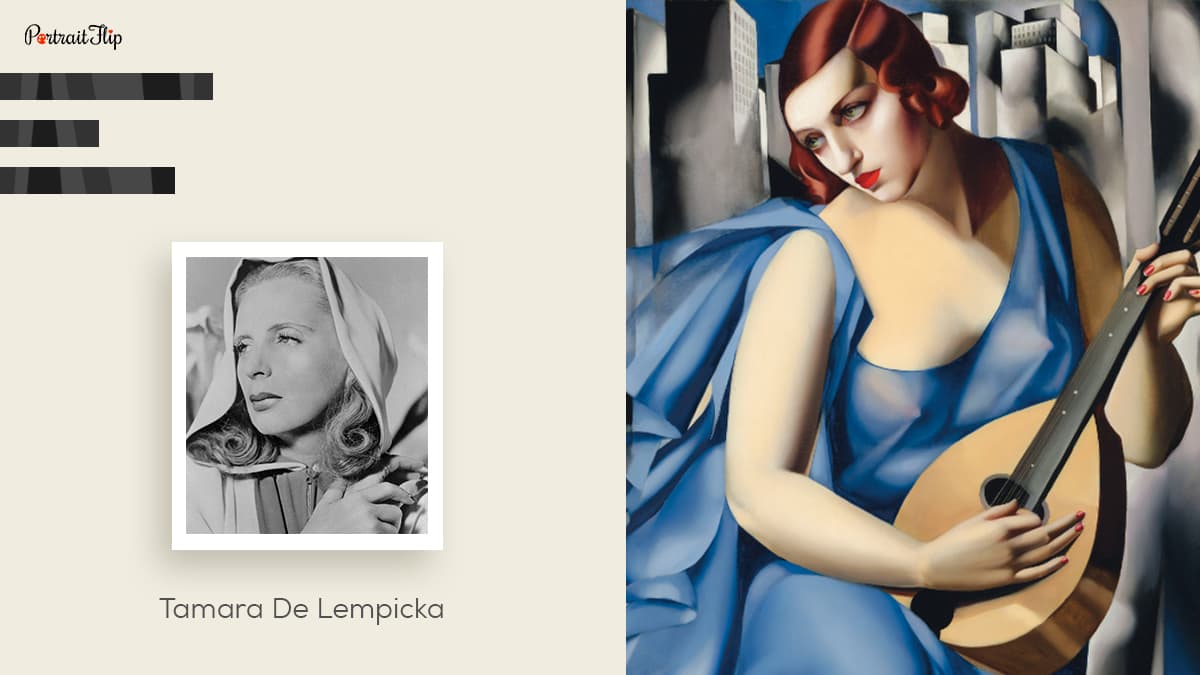
| Date of Birth | 16 May 1898 |
| Date of Death | 18 March 1980 |
| Nationality | American, Polish |
| Known For | Portrait Painter |
| Periods Belong To | Art Deco |
| Famous Paintings | Irene and Her Sister, Portrait of Ira P., Blue Woman with a Guitar, and more |
Polish born painter Tamara De Lempicka was the most talented and sought-after female painter.
Her works were ahead of their times, inclining towards beauty, sexual desires, and intimacy.
You can identify her works from miles away as they contain elements of timeless beauty and glamor.
She’d create art in a way that aligned with each element of art.
The colors she used would match the background; the figures with sharp contours and stunning textures undoubtedly stunned the viewers.
The famous female painter was admired for her work because she knew how to fuse classical and contemporary styles.
Whatever she produced later became popular and historical—perhaps that’s why Tamara’s works influenced a large audience.
Besides, her works were very clear, one could evidently see the styles she believed in.
Tamara, is arguably the record-breaking female painter who worked on several projects and held a superior position in art deco style.
5. Elisabeth Louise Vigée Le Brun
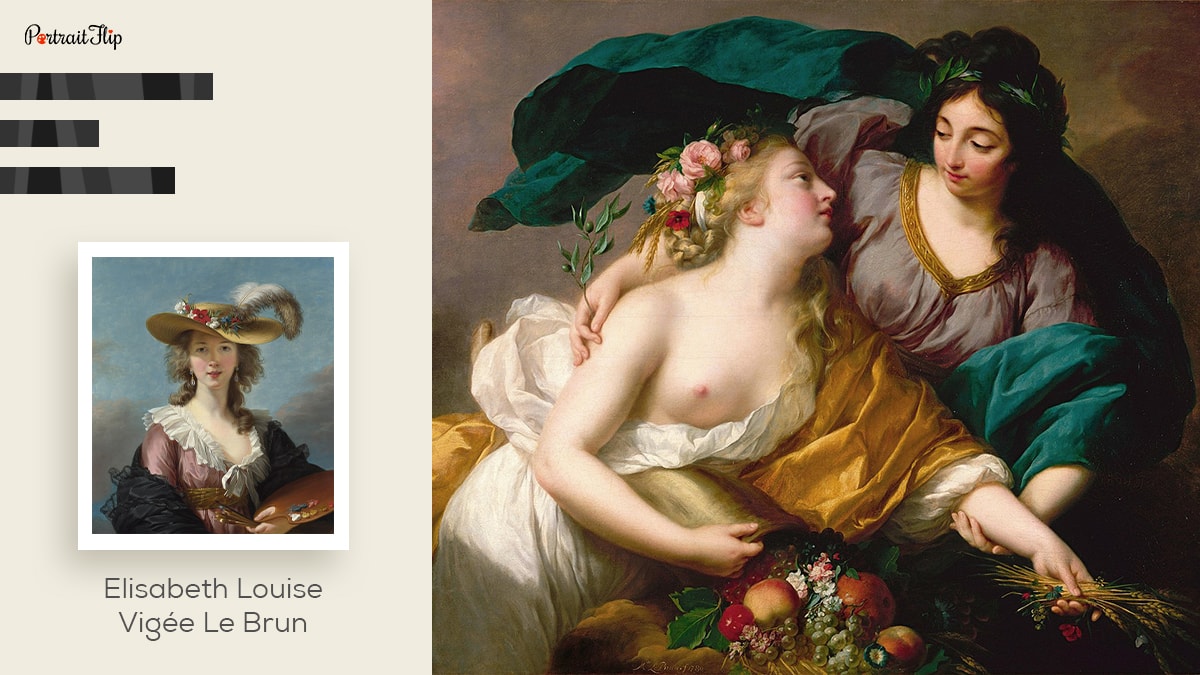
| Date of Birth | 16 April 1755 |
| Date of Death | 30 March 182 |
| Nationality | French |
| Known For | Portrait Painting |
| Periods Belong To | Rococo, Neoclassicism |
| Famous Paintings | Self Portrait in a Straw Hat, Self-portrait at age sixteen, Self-portrait with her Daughter Julie, and more |
The word prolific is an understatement to describe the class and maturity of this famous female painter.
French artist Elisabeth produced over thousands of art and landscape paintings in her professional career.
She was a well-known and prominent female painter who helped bridge the gap between Rococo style and Neoclassical period.
Born into a modest family, Elisabeth’s father was a painter, who helped her pursue art and played a key role in her professional success.
She was a skilled portrait painter who always remained under the spotlight.
Her success was as surreal as her professional journey—overwhelming with life altering obstacles and distractions.
Her style was different and elegantly beautiful as her portraits featured aristocratic women in a more natural and detailed way than those of her contemporaries.
Countless events contributed to her success, but her life changed when she earned the interest of kings, becoming the official painter of Queen Marie Antoinette.
6. Sofonisba Anguissola
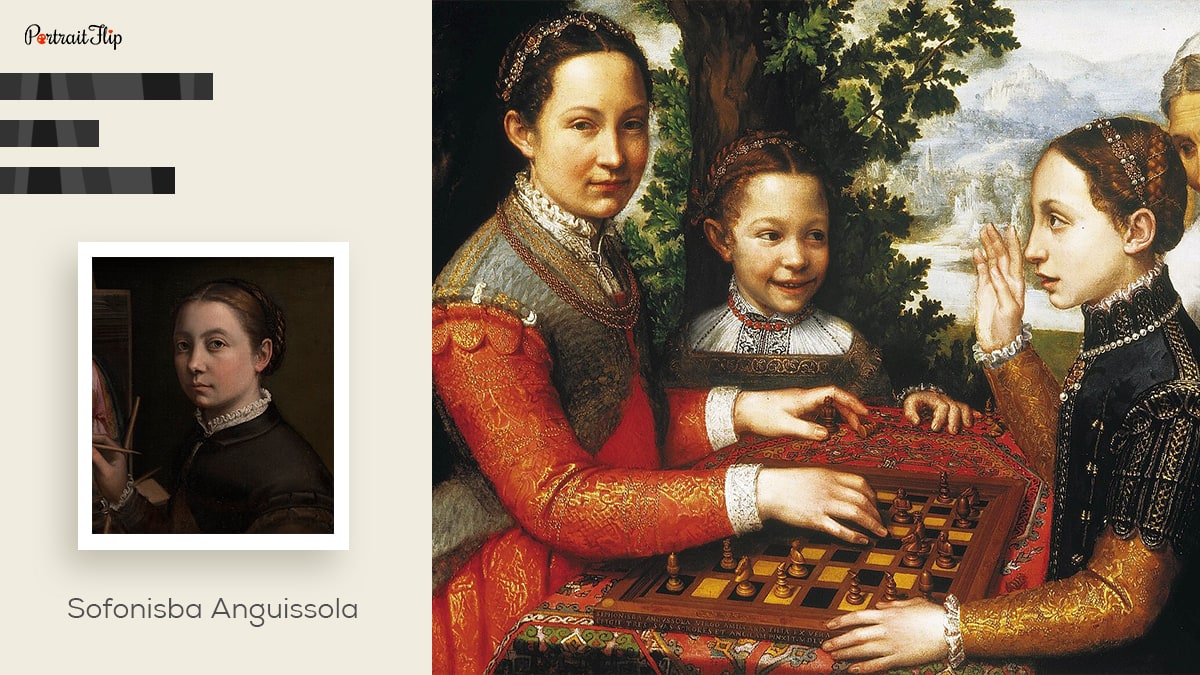
| Date of Birth | 1532 in Italy |
| Date of Death | 16 November 1625 |
| Nationality | Italian |
| Known For | Self Portraits |
| Periods Belong To | Renaissance |
| Famous Paintings | Self-Portrait, Portrait of Elena Anguissola, Portrait of the Artist’s Sisters Playing Chess, and more |
Sofonisba Anguissola was probably the first world wide famous female painter.
Oftentimes, she credited her father, who ensured that she and her elder sister would receive a fair amount of education in art.
By the time the Renaissance became prominent in Spain, she had already became a well-known female artist.
The professional journey of hers saw various downfalls, but she knew how to bounce back and never blamed to her misery.
She fought like a warrior and worked under various local painters, as it was difficult for a woman to work if one’s family didn’t have their elders in art.
Sofonisba’s talents caught the attention of Michelangelo, who later helped her with her style; whose works she absorbed and took inspiration from.
Her first professional breakthrough was probably when she received permission to produce portrait art for the courtroom of King Philip II of Spain.
Born into a poor family, she made her way to Royal, which was nothing less than big achievement.
She later became an influential figure of the Italian Renaissance, and her influence was profound in all parts of Europe.
(Also Read: 15 Famous French Painters)
7. Artemisia Gentileschi
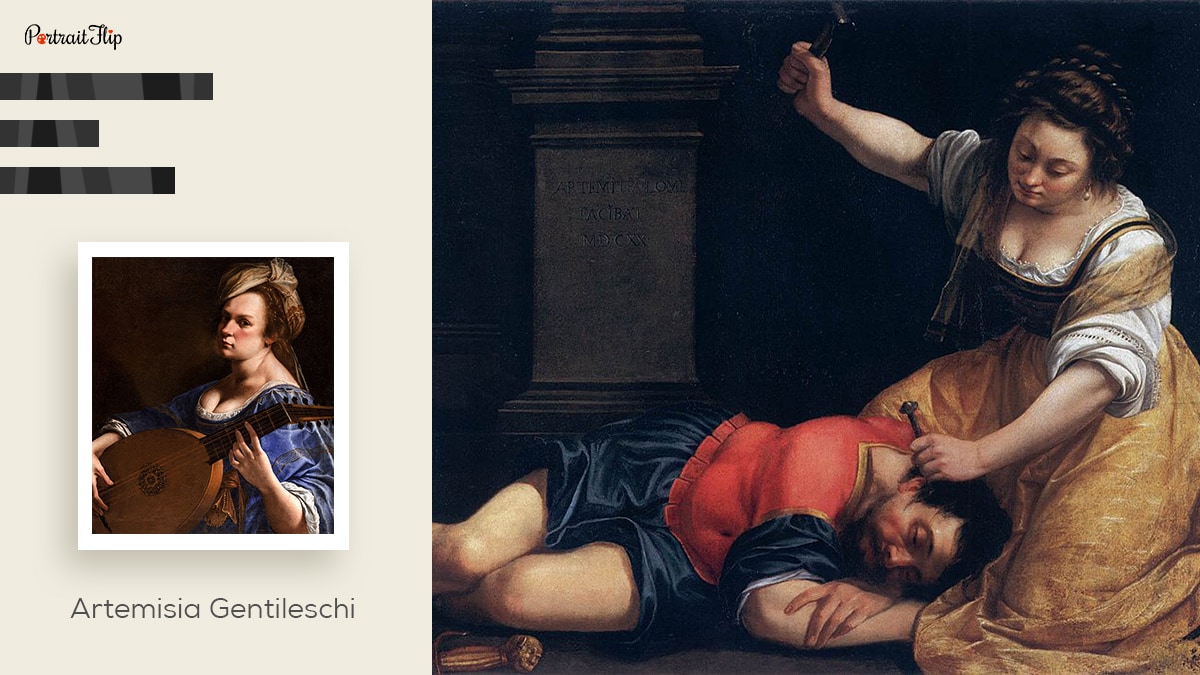
| Date of Birth | 8 July 1593 |
| Date of Death | 1653 in Italy |
| Nationality | Italian |
| Known For | Portrayal of strong subjects like power of women |
| Periods Belong To | Baroque |
| Famous Paintings | Judith Slaying Holofernes, Susanna and the Elders, Danaë, and more |
Artemisia Gentileschi was a phenomenal talent who started painting at a very early age.
Her father was the first tutor who taught her the basics of painting and encouraged her to stay focused on art.
She had been unstoppable from a young age, as she was the first woman to make it to the Florence Academy of Fine art.
Art was in her blood, soul, and mind, perhaps, that’s the reason she was among the very few whose artwork became popular before the age of 25.
Her family background always played a key role in her success. Because her father, at a very early age, introduced her to art, and taught her how to mix colors and use brushstrokes in different fashions,
Artemisia’s self portraits are widely popular, which she made while standing in front of a mirror.
Her work “Self-Portrait as the Allegory of Painting’ was created by keeping two mirrors on either side, facing each other.
This way, she made the art from a perspective she was not normally aware of.
She’s a known female painter of Italian Baroque period who also produced some of the finest mythological and biblical/Jesus paintings.
8. Judith Leyster
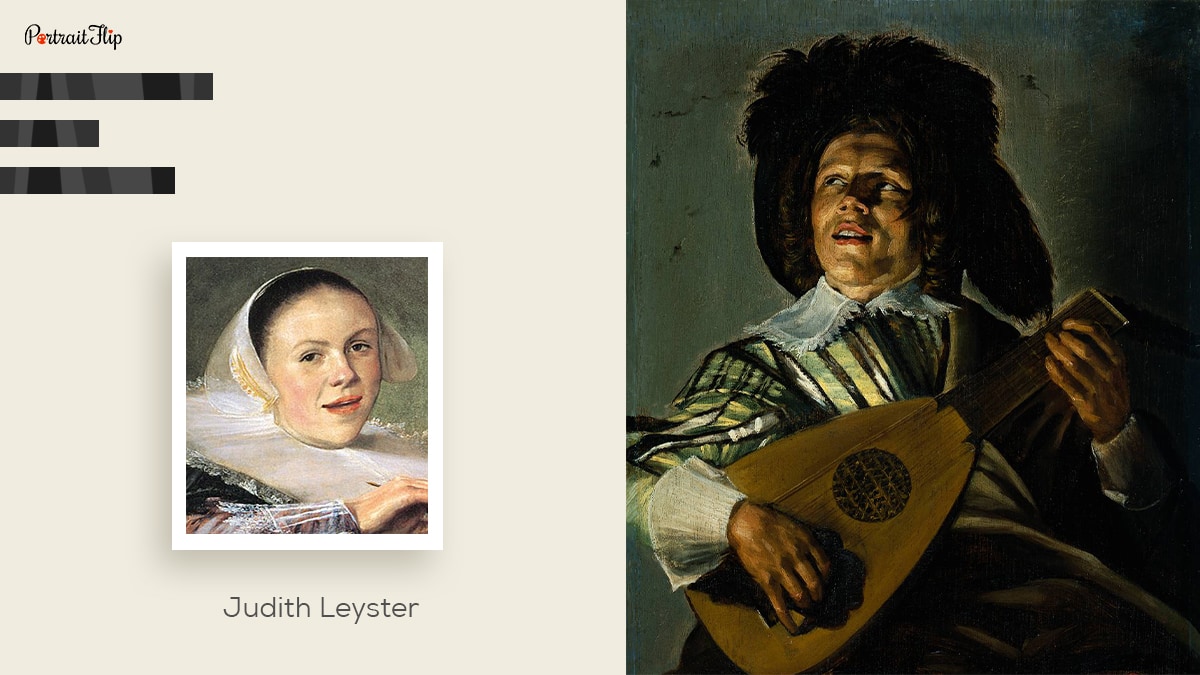
| Date of Birth | 28 July 1609 |
| Date of Death | 10 February 1660 |
| Nationality | Dutch |
| Known For | Portraits and Still Life |
| Periods Belong To | Baroque, Dutch Golden Age |
| Famous Paintings | Self-portrait by Judith Leyster, The Proposition, The Concert, and more |
Judith Leyster was the most extraordinary female painter from the Netherlands.
She was the finest creation of the Dutch Golden Age and a creator of the world’s most talked about portraits, genres, and still life artworks.
By the age of 24, Judith had achieved big things not everyone of her age could ever achieve.
She held a prestigious position in City’s Prestigious painters guild but remained underrated for many years until the 19th century.
Judith ran some workshops with the intention of producing heart-touching pieces. She believed in work that involved negligent drama and pure hardwork.
Whatever she drew had a happy and pleasing tone, with subjects being showed in domestic activities or merrymaking.
Her works heavily influenced many people at the time but her wedding to her fellow contemporary put a full stop on her solo artistic journey. She had a short professional career, that was shut due to her increasing domestic and family responsibilities.
9. Rosa Bonheur
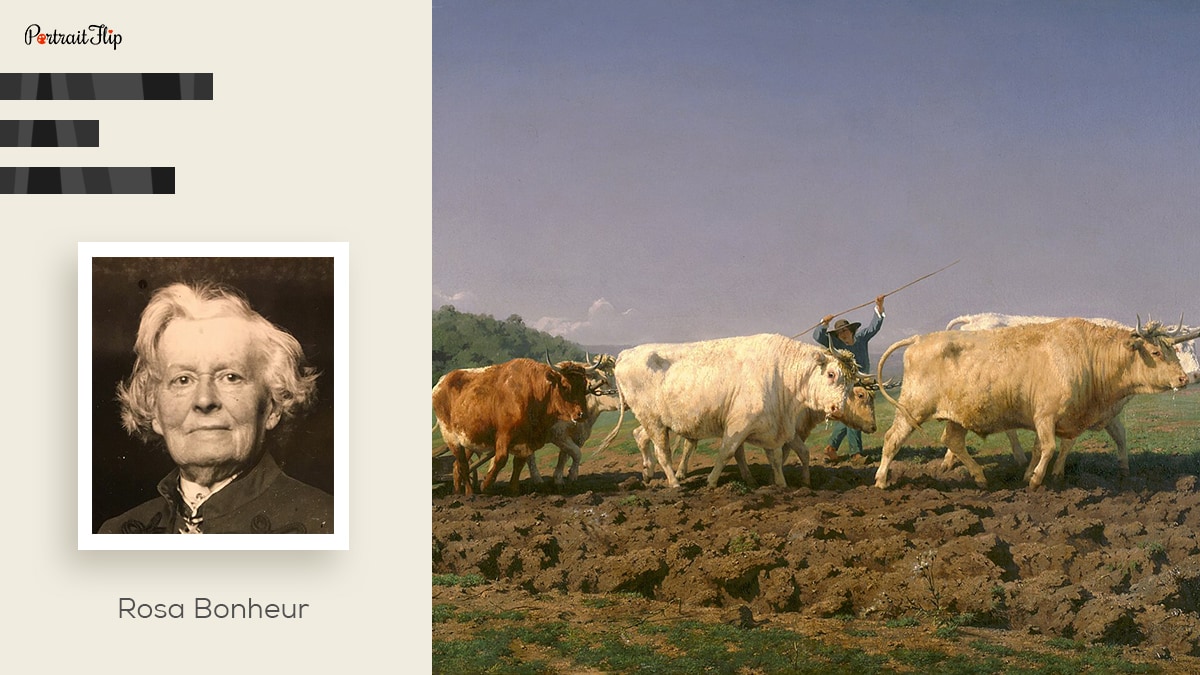
| Date of Birth | 16 March 1822 |
| Date of Death | 25 May 1899 |
| Nationality | French |
| Known For | Self Portraits featuring animals |
| Periods Belong To | Realism |
| Famous Paintings | The Horse Fair, Weaning the Calves, Sheep by the Sea, and more |
Rosa Bonheur was the bravest and most hard-working female painter on the list.
She was a feminist, an art lover, and a qualified figure who broke boundaries and stereotypes to build her name.
The French female painter Rosa was a lesbian. Being a lesbian was a sin, especially when you lived in society where women’s opinions were silenced.
But Rosa was a warrior who stood up for herself and ignored the voices that drained her.
Rosa’s unbreakable focus and efforts made her produce one of the finest pieces of art ever displayed at the Salon.
Her success became evident in no time, as she became a famous female painter in both the United States and Britain.
Regardless of how badly her personal choices affected her professional endurance, she remained focused and stated her opinions through art.
She was also known as a realist painter who produced large format art featuring various animals.
10. Berthe Morisot
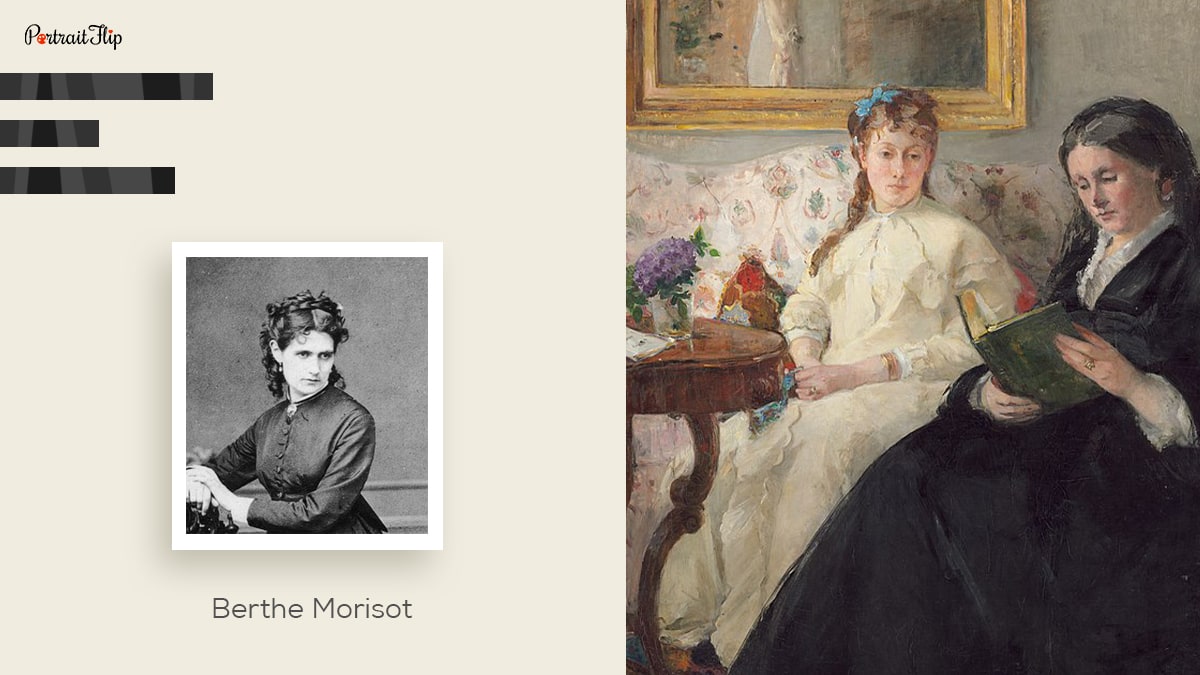
| Date of Birth | 14 January 1841 |
| Date of Death | 2nd March 1895 |
| Nationality | French |
| Known For | Painting and Printmaking |
| Periods Belong To | Impressionism |
| Famous Paintings | The Cradle, Woman at Her Toilette, The Harbor at Lorient, and more |
Berthe Morisot was the most famous painter of the 19th century who worked with impressionist painters like Cezanne, Renoir, and Degas.
She was from an affluent family but she chose to struggle to learn art and make her passion a profession.
Berth would make domestic scenes and preferred using pastels, watercolor, and charcoal.
Many renowned figures shaped her professional journey, but she would credit Edouard Manet the most, who featured her in many of his works.
Berthe was also known as the only woman involved in the formation of Impressionism.
Speaking of her nature and professional behavior, she was dedicated and talented.
Regardless of what people said behind her back, she continued working on art which brought immense happiness to her life.
Oftentimes, viewers would make remarks about her works, calling Bether’s artworks unfinished and meaningless.
But she neglected those voices and would claim that they were raw and full of emotions.
She knew she lived in a patriarchal society, and no matter what she did, people would always raise their eyebrows.
11. Hilma af Klint
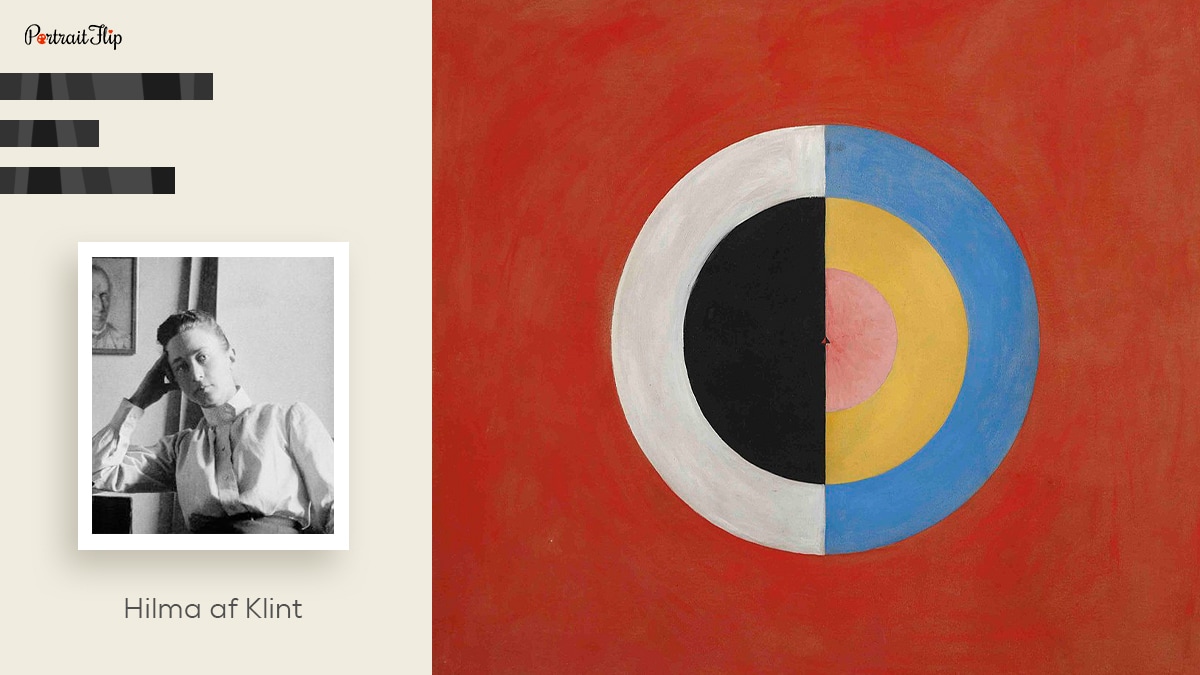
| Date of Birth | 26 October 1862 |
| Date of Death | 21 October 1944 |
| Nationality | Swedish |
| Known For | Abstract Paintings |
| Periods Belong To | Abstract Art, Realism, and Modern Art |
| Famous Paintings | The Ten Largest, Svanen, The Ten Largest, No. 7, Adulthood, and more |
Hilma af Klint is arguably an underrated female painter of all time.
We credit Wassily Kandinsky and Piet Mondrian so often for their works that we’ve forgotten Hilma’s contributions to abstract art.
Hilma was one such abstract painter who believed in producing detailed artwork and was a master of creating bold and colorful works.
The famous female painter knew the taste of people, which is why, she didn’t let anyone see some of her works, which was contrary to their belief systems.
Hilma was fond of nature, and whatever she created had some sort of connection with it. She was also a part of a religious movement and learned the way of transcending spirits.
Her interest in spirits and the practices of seances made her look eccentric. But her abstract paintings covered a wide range of subjects, which she experienced in her personal and professional lives.
(Also Read: 18 Famous Abstract Painters Who Liberated the Art World)
12. Yayoi Kusama
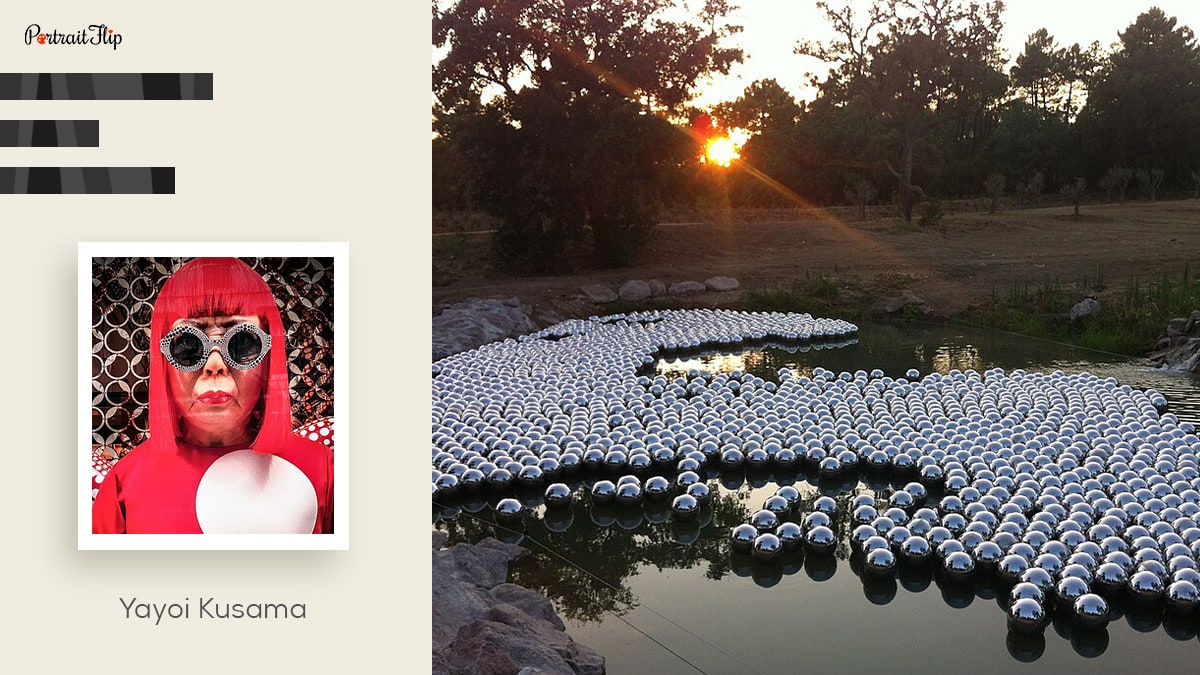
| Date of Birth | 22nd March 1929 |
| Date of Death | – |
| Nationality | Japanese |
| Known For | Polka Dot Paintings |
| Periods Belong To | Pop Art, Feminist Art, Minimalism, Contemporary Art, and Environmental Art |
| Famous Paintings | Infinity Mirror Room Fireflies on Water, Dots Obsession, Butterfly, Flowers, and more |
Talking about contemporary art, without expecting Yayoi Kusama’s name in between is unreasonable.
The famous female painter has been the most influential figure in Japanese art.
Her work speaks about her lifestyle, vision, and ideas.
Best know for her feminist views, Yayoi, incorporated several concepts into her works.
Yoyoi was not only regarded as a famous Japanese painter, but also a successful sculptor who was drawn by polka dots and neon colors.
Her works always remained in the limelight, especially the ones that were a combination of Abstract Expressionism and Minimalism, mainly created in the 1960s.
Yayoi has influenced millions of people, and is continuing to do so—but did you know she suffered from hallucinations, and rose to fame after being admitted to the psychiatric room in Japan.
Her health began improving when she was provided with art supplies—art incentivized her and began playing a key role in her well-being.
13. Angelica Kauffman
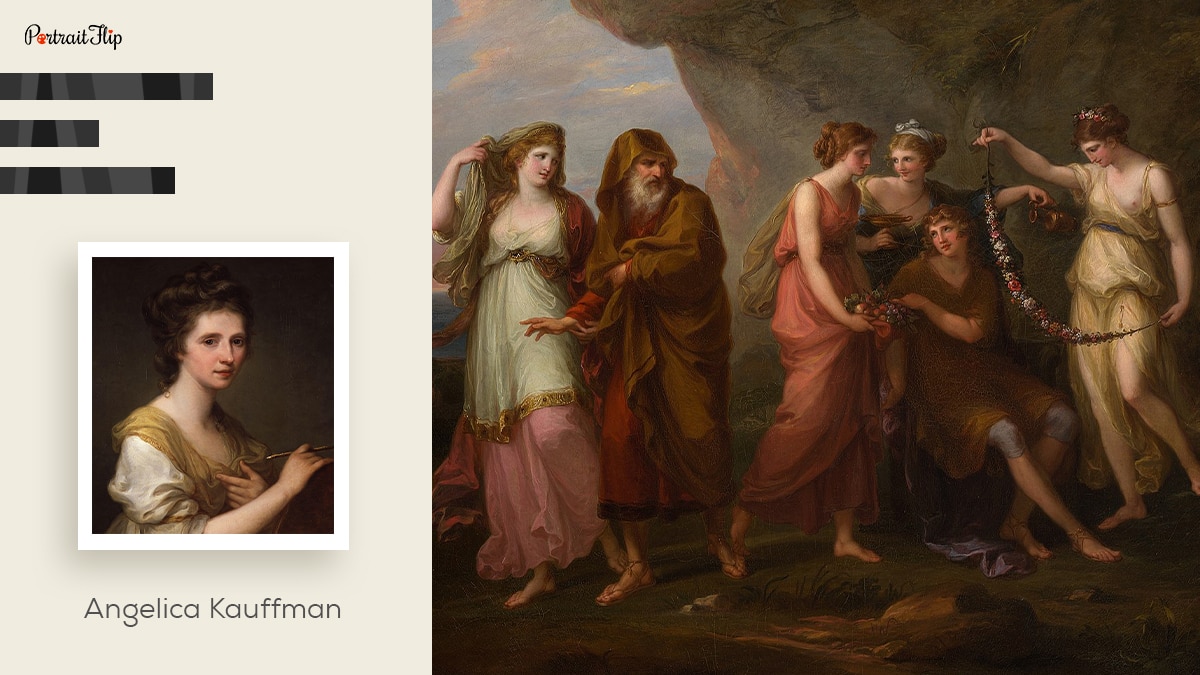
| Date of Birth | 30th October 1741 |
| Date of Death | 5 November 1807 |
| Nationality | Austrian, Swiss |
| Known For | Portraits and History Paintings |
| Periods Belong To | Neoclassicism |
| Famous Paintings | Portrait of a Lady as a Vestal Virgin, The Sorrow of Telemachus, Portrait of Winckelmann, and more |
Angelica was an achiever, a daughter of a skilled painter, and one of the only two women who founded the Royal Academy of Arts.
She spent most of her childhood days making portrait art, which she was proficient in.
Thanks to her father, who monitored her work and helped shape her artistic approach.
The Swiss painter Angelica had a significant influence on Italian art; her artworks mainly historical paintings and portraits of aristocrats, defined her knowledge, influencing massive masses.
She catered to different types of audiences, from classical to allegorical.
Undoubtedly, Angelica was the 18th century’s most versatile female painter and also left indelible marks on Neoclassical art.
As time passed, she reshaped her painting styles and techniques, and sealed a prominent and permanent spot among art communities and groups.
(Also Read: 49+ Types Of Paintings Styles And Techniques)
14. Helen Frankenthaler
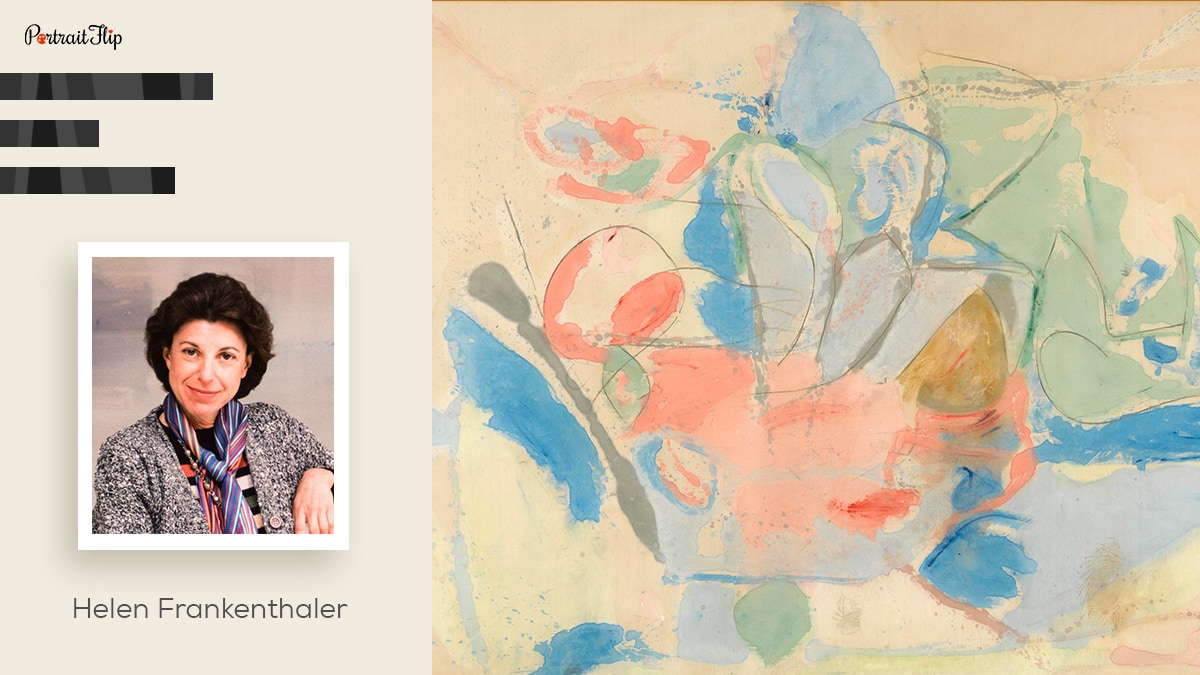
| Date of Birth | 12 December 1928 |
| Date of Death | 27 December 2011 |
| Nationality | American |
| Known For | Abstract and Color Field Painting |
| Periods Belong To | Modern art, Abstract expressionism, Post-painterly abstraction, Color field, Lyrical abstraction |
| Famous Paintings | Mountains and Sea, Small’s Paradise, Blue Form in a Scene, Stride, and more |
Helen’s contribution to abstract expressionism is painfully underrated.
If you look at her artwork, you’ll realize the depth and intricacies of abstract expressionism.
Probably no other painters have, at a very early age, used those combinations of colors and incorporated subjects as Helen did.
She wasn’t an expert at abstraction but her style evolved and became more interesting with each passing year.
America always appreciated her effort and the work she produced, but she was a well-respected female painter in European countries as well.
Perhaps, because she had a long professional journey, meaning her six decades of experience contributed and influenced a massive mass.
And one can’t neglect the importance of her role in transitioning Abstract art from minimalistic styles.
15. Catharina Van Hemessen
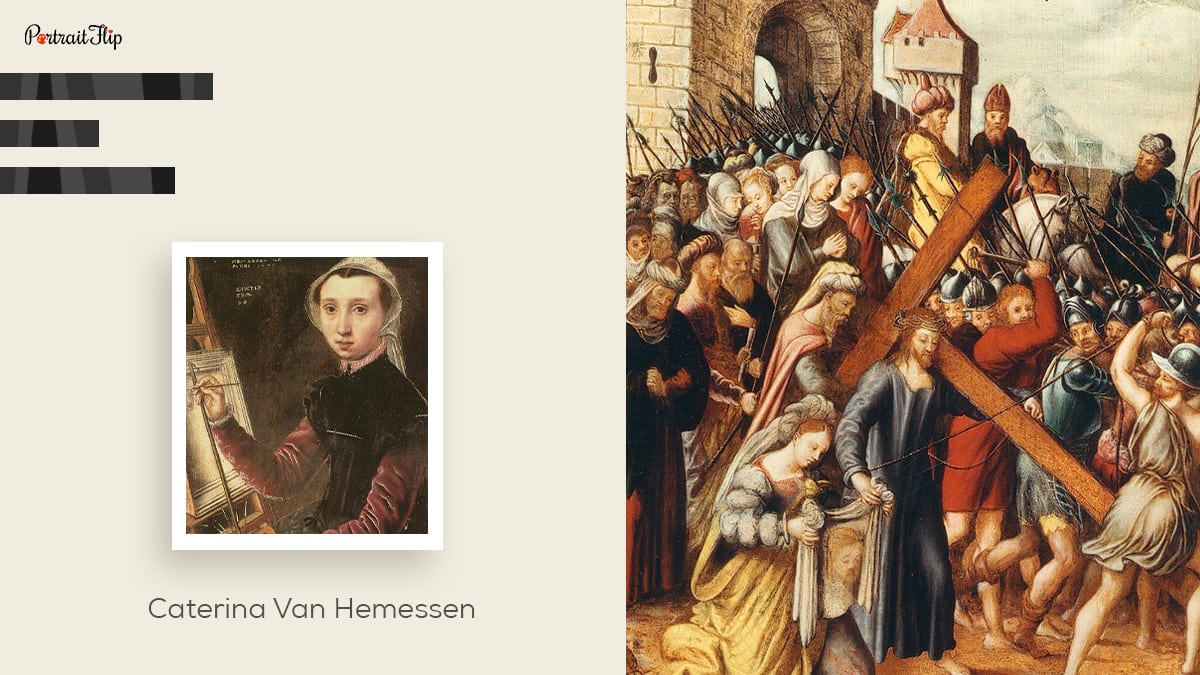
| Date of Birth | 1528 in Belgium |
| Date of Death | 1565 in Belgium |
| Nationality | Flemish |
| Known For | Portrait and Religious Painting |
| Periods Belong To | Renaissance, Northern Renaissance |
| Famous Paintings | Self-Portrait (van Hemessen), Portrait of a Child, Portrait of a Man, and more |
Caterina’s journey is no less inspiring than any famous female painter’s story we’ve heard.
The biggest reason behind her success was her father, who aided her in every stage of her artistic journey.
Without Caterina’s father, she wouldn’t have come as close to success as she did.
Her father’s extensive contacts in the world of art enable her to pursue a higher education in art and claim more freedom as a painter.
Throughout her professional career, she met various known painters, but the one who impacted her life the most was her father, who was a master of genre and historical art.
Caterina’s works included a large number of self portraits and small-sized paintings of women. From the very beginning, she set high standards for painters who pursued portraiture.
That’s why it was inevitable for people not to dislike her, especially for her in-depth and complex works.
16. Louise Bourgeois
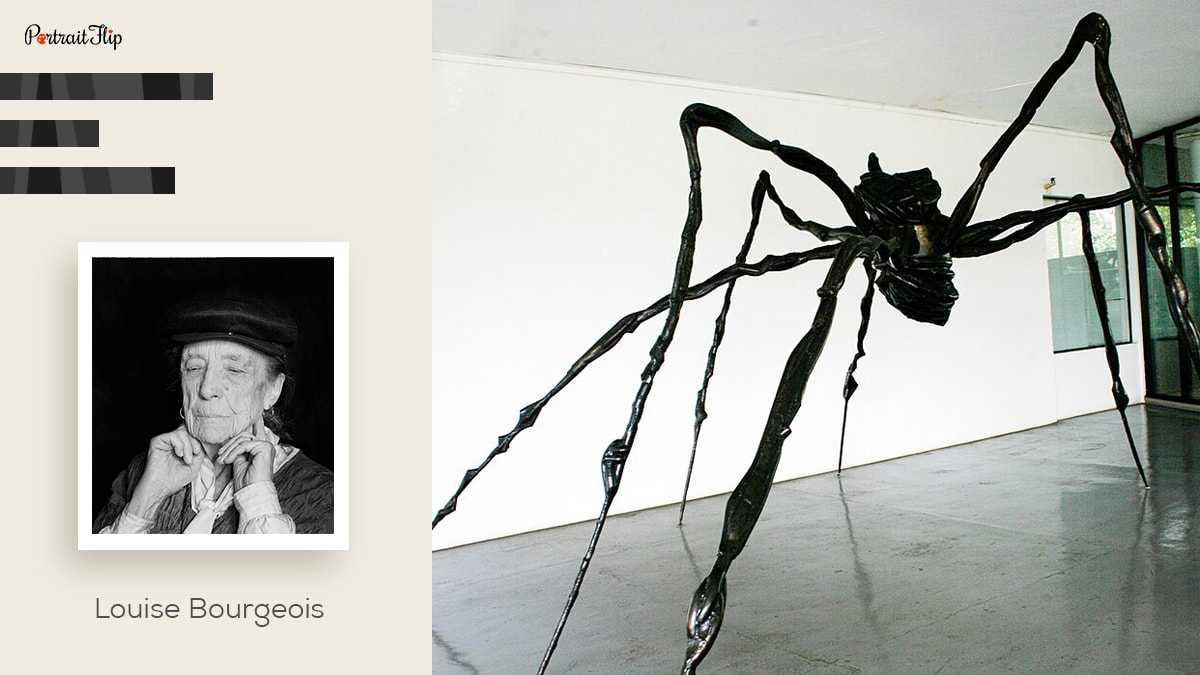
| Date of Birth | 25 December 1911 |
| Date of Death | 31 May 2010 |
| Nationality | American, French |
| Known For | Large Sculptures, Installation Art, Printmaker |
| Periods Belong To | Contemporary art, Feminist art, Modern art, Surrealism, Modernism |
| Famous Paintings | Spider (Bourgeois), Maman (sculpture), Janus Fleuri, Mamelles, and more |
Louise’s second stint in art turned out to be rewarding and inspiring.
She was never a part of any art movement, but her style was inclined towards abstract expressionism.
The diversity and hustle involved in her life explain a lot about her passion and perseverance.
Louise, best known for rebelling against conventional ideas, made some weird and controversial pieces of art.
Born into a French family with a business in tapestry restoration, Louise dropped her formal education and pursued art for good.
Before that, she used to work at her father’s workshop. But when she came back to art after leaving mathematics and geometry at the Sorbonne, she fully dedicated her time to her passion.
She’d produce sculptures, prints, and paintings. Oftentimes, her artwork evokes various emotions such as jealousy, anger, abandonment, loneliness, and fear.
17. Adélaïde Labille-Guiard
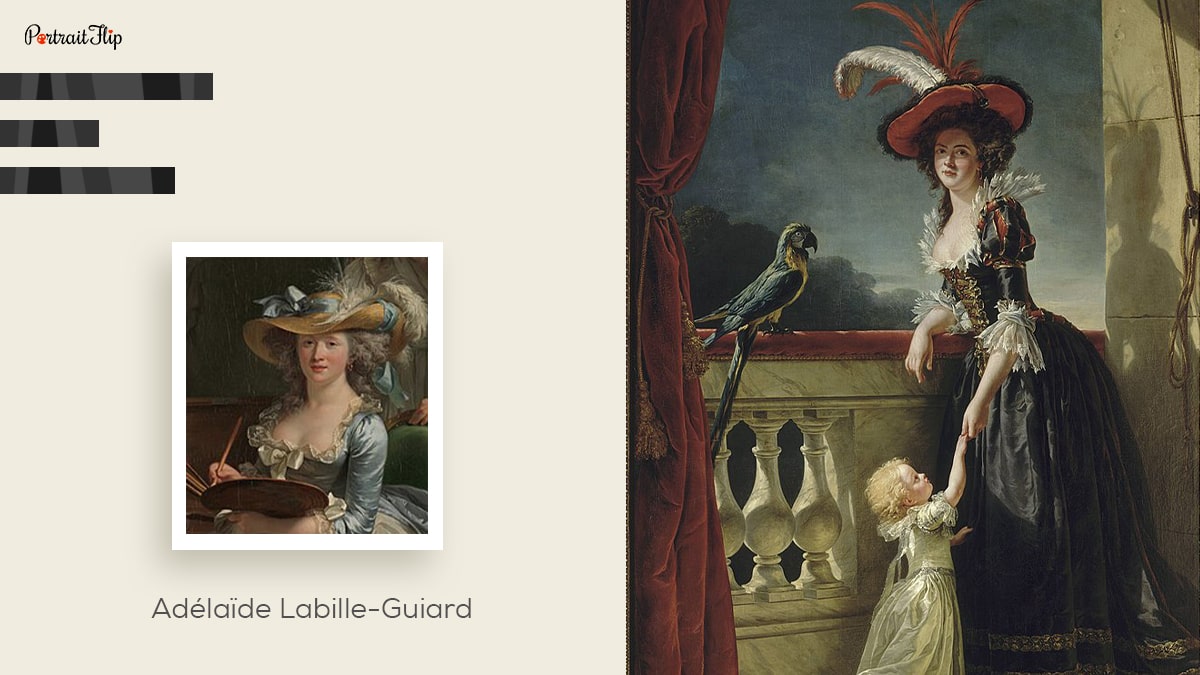
| Date of Birth | 11 April 1749 |
| Date of Death | 24 April 1803 |
| Nationality | French |
| Known For | Miniature, Painting, Pastels |
| Periods Belong To | Rococo, Neoclassicism |
| Famous Paintings | Self-Portrait with Two Pupils, Portrait de Joseph Benoît Suvée, Portrait of a woman, and more |
Adelaide was known for various reasons. First, she was an upright feminist; second, she worked for a myriad of royal and aristocratic patrons.
It wouldn’t be wrong to call her a genius, as she knew the art of rebelling against patriarchy through art.
Success didn’t come her way the moment she entered the arts. It took some time, but her grace and ambitious attitude captured many people’s attention.
The works of Adelaide triggered many so-called art lovers, whose propaganda was to keep men in higher positions.
But despite all the hate and criticism she received, she stood up like a lioness and set up a studio at the Louvre, making her the first woman to do so.
Adelaide often attributed her success to herself, as she never bent down to those who tried to defame her and drag her into controversy for whatever reasons.
Not only was she a famous female painter, but she was also an influential teacher who worked for nothing but the betterment of women.
You may not know this, but Adelaide, set various examples for women, especially when she became the first female artist to be granted membership at the French Royal Academy.
Why Have There Been No Great Female Artists?
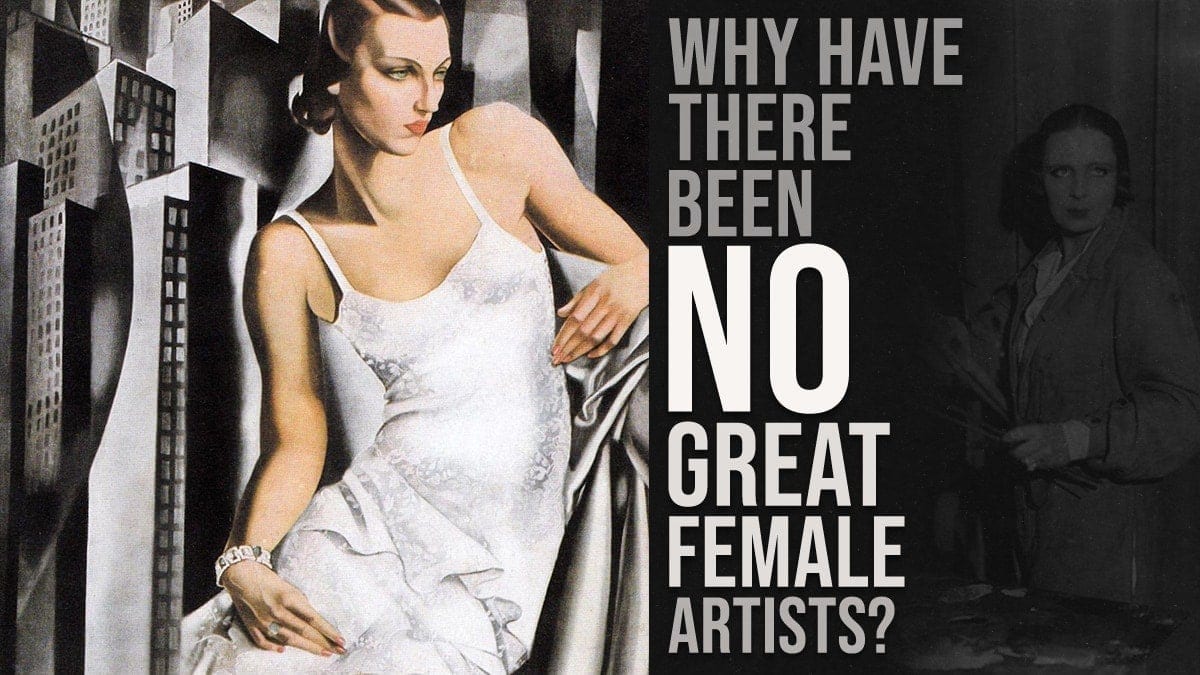
“Why are there no great women artists?’ sounds as ignorant of human geography as the query ‘Why are there no Eskimo tennis teams?”
Francine du Plessix Gray
Prestigious museums such as the Louver, MoMA, MET, the Rijksmuseum, the Hermitage, etc. house less than 11% of women artists in total.
When we think of famous artists or best painters, we think of DaVinci, Picasso, Van Gogh, Renoir, Warhol, Botticelli, or Rembrandt, and artists along these lines.
And undoubtedly, they are some of the greatest painters of all time, but I’m sure they aren’t the only ones.
Did you notice that all these painters are men? That our history has failed us to educate us about artists that aren’t men.
Listing as many great women artists as male artists is nearly impossible.
“She has the talent of a man”
The question that lies ahead is; are women not capable of being great artists? Are all recognized artists coincidentally male? Or has our society and institutions been incapable to recognize and facilitate women’s works?
Art is more than just a drawing or splash of color; it reflects and influences how we view our society and people.
Women as artists have faced gender inequality throughout history and this is a reoccurring topic that never gets the attention it deserves.
But the real question here is: What does the male domination of art history say about the way we look at women?
Even though art is viewed as a free and autonomous activity, the contrary seems to be true.
For a very long time, women were not allowed in art guilds and academies.
They were “deprived of the possibility of creating major art works’” (Harris, 2001).
“The fault lies not in our stars, our hormones, our menstrual cycles, or our empty internal spaces, but in our institutions and our education”
Linda Nochlin
Knowing the history of women in art is vital to fully appreciate their work and comprehend the fundamentals of their creation.
Along with understanding their vulnerability, which came from their position in society during their respective times.
In addition to being a female painter, there are many paintings of women that highlight various traits.
Paintings are a great way to express emotions, it is more than the act of painting,
It’s always about the emotions a painting evokes in us.
You don’t need to be a professional painter to have a portrait painting of you or your loved one.
We at PortraitFlip paint your favorite photo into a handmade painting.
Get your 100% hand-painted painting by professionals today!
End Note:
Dear reader,
The purpose of this article is to build a more inclusive and richer picture of art history.
We honor their contribution to the art world as painters and admire them for their courage.
It is due to these women who came before us that we have the freedom to create the lives we want to live today.
I hope you found this article on female painters answering all questions, if we have missed any points or information that you wish us to add, please let us know in the comment section below.
All facts and figures are taken from official sources.
You can also follow us on Instagram and subscribe to our YouTube channel.
If you like this article, do share it further!
And if you have reached here, thank you!
FAQs
Frida Kahlo is one of the most famous female artist. Along with Georgia O’Keeffe and Marry Cassatt.
Famous Frida Kahlo paintings are: • The Two Fridas (1939) • Self-Portrait with Thorn Necklace and Hummingbird (1940) • The Wounded Deer (1946) • Self-Portrait with Cropped Hair (1940)
These are some of the famous female painters from the renaissance era. • Sofonisba Anguissola • Levina Teerlinc • Lavinia Fontana • Clara Peeters • Catharina van Hemessen
These are some of the famous female painters of the 20th century • Mary Cassatt • Hilma af Klint, • Vanessa Bell • Suzanne Valadon • Lilla Cabot Perry • Emily Carr

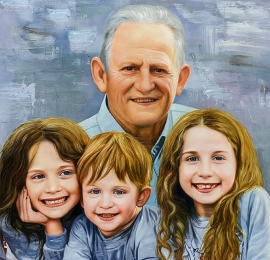
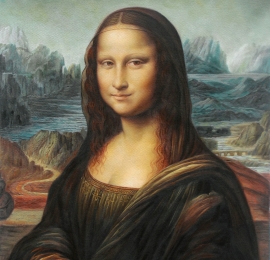
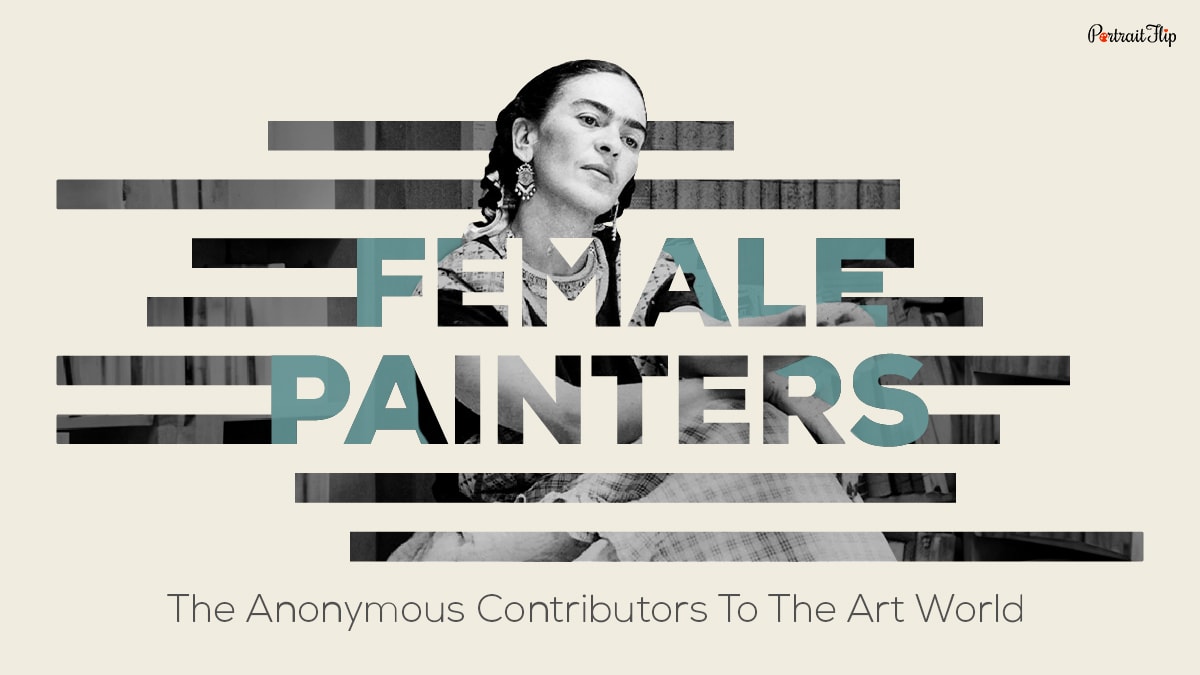
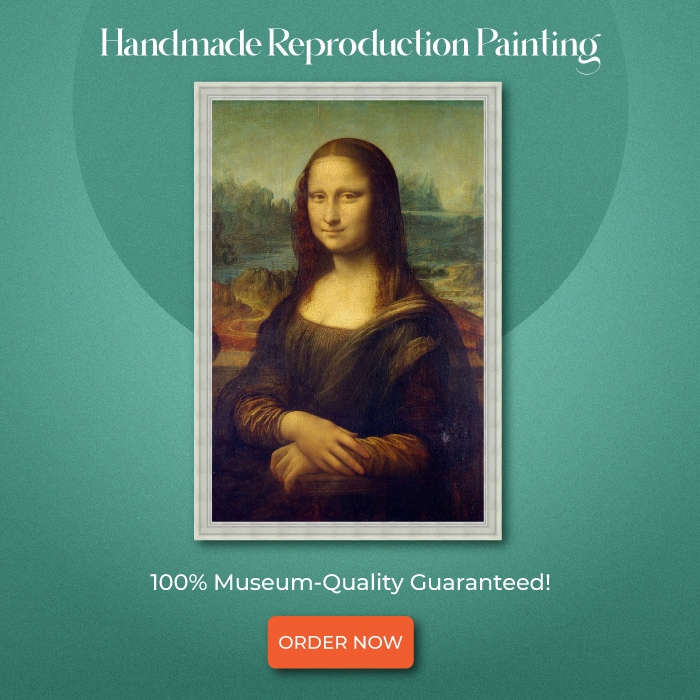

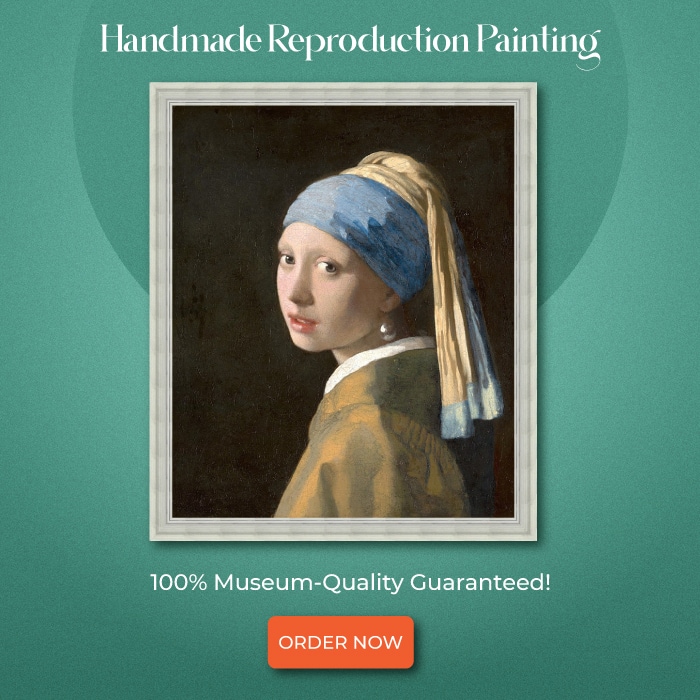
Pingback: 25+ Famous Black Artists in Art History Who Only Ever Distinguished Color In Art
Pingback: Famous Black Artists in Art History Who Only Ever Distinguished Color In Art | African Elements